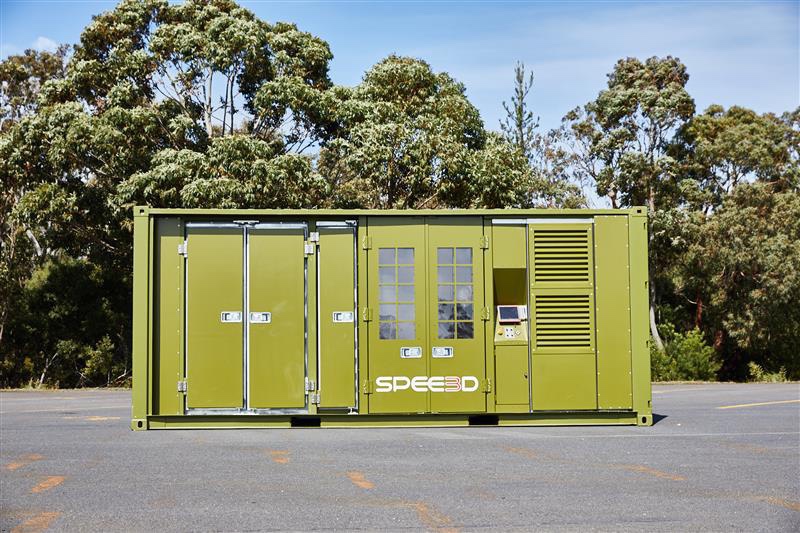SPEE3D isn’t planning on doing its own missions to space any time soon. Its CEO, Byron Kennedy, was quick to point this out when I asked about the company’s recently unveiled, successful print of a rocket nozzle.
“We’re not going to build rockets, put that out there,” Kennedy said with a chuckle. “This is about demonstrating the technology: showing that cold spray can make the nozzles. Trying to launch rockets, that’s not us.”
In a way, that nonchalant qualifier perfectly captures the strengths of the Australia-based original equipment manufacturer (OEM): SPEE3D knows what it’s good at, and it knows the niche it’s aiming for in the additive manufacturing (AM) sector. Combining that cohesiveness with Australia’s quiet emergence as a contender in the global AM market, SPEE3D has a formula that could lead to the company’s attaining new heights as soon as next year.
Another advantage that SPEE3D has in its favor is its apparent tirelessness. I spoke with Kennedy the Friday before Formnext 2022, when he was on his way to LAX to fly back to Australia. He’d just attended the US Army’s Project Convergence war games at Fort Irwin National Training Center (NTC) in the Mojave Desert, which were also held at Camp Pendleton in October of 2022.

Having been observers for Project Convergence 2021, the British and Australian militaries (both of which are customers of SPEE3D) actively participated this year. The UK Army invited SPEE3D to attend the war games at Fort Irwin NTC, where the company demonstrated its WarpSPEE3D printer. Although he couldn’t disclose any specifics, given the nature of the demonstration, Kennedy did note, “Everyone was sort of running for cover when the storms were coming in, but the printer was not missing a beat the whole time.”
That is the niche that the company is aiming for: the ability to produce metal parts, quickly and reliably, from anywhere. As Kennedy put it, “[The] 3D printing [sector] has talked about that for a long time; but we’re the ones who are actually putting that into process. …The closer you get to the front line — whatever the front line is — the better.”

This is an objective epitomized by the XSPEE3D, a containerized production cell that the company recently released. Amongst the products that SPEE3D makes, I think this one may have the greatest potential, with the reason being precisely what Kennedy said about “the front line.” Aside from its technology, the attribute most responsible for giving the company its edge is the grasp it has on how the operational logic of the military can translate into supply chain solutions for industry at-large.
When I asked Kennedy about how he envisions the makeup of SPEE3D’s future customer base, he had no hesitation with his answer: “Long-term, the aim is 50/50 defense and industrial.” He then explained, “[Defense] enables us to open doors to other industries. If we’re printing rocket nozzles, if we’re printing parts for tanks, it gives other industries the confidence that the material is good, the parts are good.”
As for what those other industries will be, maritime and mining are two that Kennedy mentioned right off the bat. Those are logical fits given that SPEE3D’s platforms leverage the relative quickness, portability, and cost-effectiveness of cold spray AM, when compared with other metal AM techniques. In addition, as Kennedy pointed out, maritime and mining make sense as industries in which SPEE3D can thrive due to the simple fact that the company is headquartered in Australia. The nation’s increasingly critical resource wealth and mining sectors, alongside its geographic remoteness from the rest of the global economy, would seem to make Australia an ideal market for AM in general, and SPEE3D in particular.
Thus, the same things that make places like Australia (and Canada) — with uncommon combinations of low population density, high resource wealth, and geographic remoteness — good environments for AM to take off in, are what explain SPEE3D’s unique potential. The company understands the solutions that AM is best equipped to provide, right now, on a global level. And SPEE3D could start providing those solutions on a much larger scale very soon, by deploying cold spray in the fashion most optimal for capitalizing on its technological advantages.
Images courtesy of SPEE3D
Subscribe to Our Email Newsletter
Stay up-to-date on all the latest news from the 3D printing industry and receive information and offers from third party vendors.
You May Also Like
Further Understanding of 3D Printing Design at ADDITIV Design World
ADDITIV is back once again! This time, the virtual platform for additive manufacturing will be holding the first-ever edition of ADDITIV Design World on May 23rd from 9:00 AM –...
3D Printer Maker EVO-tech Reborn as NEVO3D — Once More With Feeling
EVO-tech was a 3D printing service and original equipment manufacturer established in 2013 and based in Schörfling am Attersee, Austria. The company produced high-quality material extrusion systems featuring linear bearings,...
3D Systems Brings 3D Printed PEEK Cranial Implant to the U.S. with FDA Clearance
For more than 10 years, 3D Systems (NYSE:DDD) has worked hand-in-hand with surgeons to plan over 150,000 patient-specific cases, and develop more than two million instruments and implants from its...
CDFAM Returns to Berlin for Second Annual Symposium
The second CDFAM Computational Design Symposium is scheduled for May 7-8, 2024, in Berlin, and will convene leading experts in computational design across all scales. Building upon the first event...































